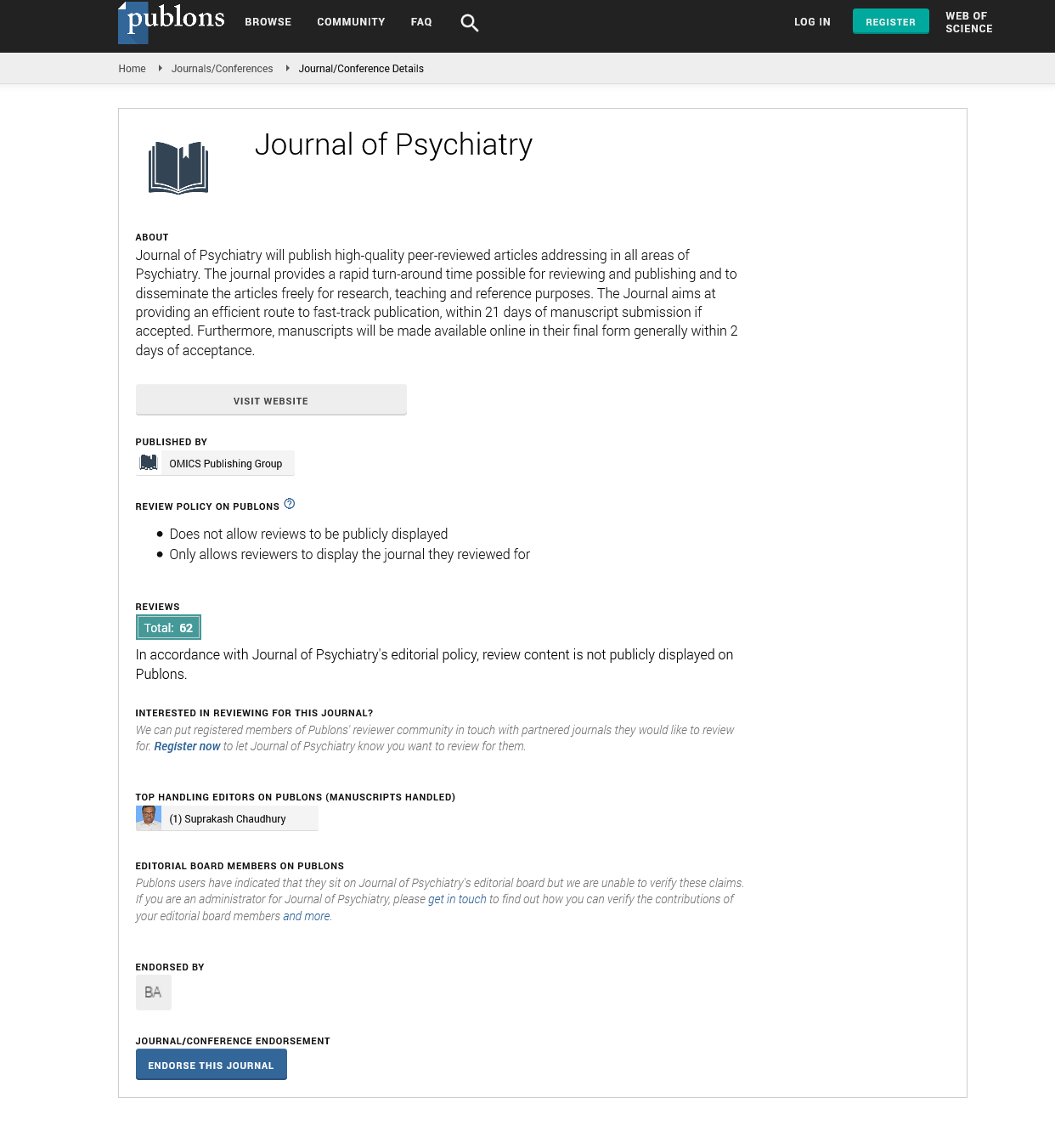Indexed In
- RefSeek
- Hamdard University
- EBSCO A-Z
- OCLC- WorldCat
- SWB online catalog
- Publons
- International committee of medical journals editors (ICMJE)
- Geneva Foundation for Medical Education and Research
Useful Links
Share This Page
Open Access Journals
- Agri and Aquaculture
- Biochemistry
- Bioinformatics & Systems Biology
- Business & Management
- Chemistry
- Clinical Sciences
- Engineering
- Food & Nutrition
- General Science
- Genetics & Molecular Biology
- Immunology & Microbiology
- Medical Sciences
- Neuroscience & Psychology
- Nursing & Health Care
- Pharmaceutical Sciences
Opinion Article - (2025) Volume 28, Issue 1
The Neuroscience of Decision-Making: How Cognitive Biases Influence Human Behavior
Annabel Patterson*Received: 01-Jan-2025, Manuscript No. JOP-25-28583; Editor assigned: 03-Jan-2025, Pre QC No. JOP-25-28583; Reviewed: 17-Jan-2025, QC No. JOP-25-28583; Revised: 23-Jan-2025, Manuscript No. JOP-25-28583; Published: 31-Jan-2025, DOI: 10.35248/2167-0358.25.28.731
Description
Decision-making is a complex cognitive process influenced by various neural mechanisms and psychological factors. While individuals often believe their decisions are based on rational analysis, extensive research in neuroscience and behavioral science suggests otherwise. Cognitive biases, which are systematic patterns of deviation from rationality, play a significant role in shaping human behavior by altering perception, judgment and choices. These biases are deeply rooted in the brain’s functioning, affecting decision-making in everyday situations, financial judgments, healthcare choices and even social interactions. At the core of decision-making are neural structures that process information, evaluate risks and rewards and regulate emotions. The Prefrontal Cortex (PFC) serves as the control center, managing executive functions such as planning, impulse control and logical reasoning. It enables individuals to assess options carefully and anticipate long-term consequences. However, despite the PFC’s role in rational thought, it does not operate in isolation. The amygdala, known for processing emotions and fear responses, heavily influences decision-making, especially in emotionally charged situations. When individuals make choices under stress or uncertainty, the amygdala can override logical reasoning, leading to impulsive or emotionally driven decisions.
Another crucial region involved in decision-making is the striatum, which is responsible for reward processing and reinforcement learning. This structure helps individuals assess potential outcomes by weighing rewards against risks. For example, dopamine activity in the striatum plays a critical role in reinforcing behaviors associated with positive experiences, often leading to habitual or impulsive decisions. Additionally, the Anterior Cingulate Cortex (ACC) contributes by detecting conflicts between different choices and helping individuals navigate complex decisions. The hippocampus, a key structure in memory formation, also plays a vital role by retrieving past experiences that shape current choices. Despite the sophisticated neural processes involved in decision-making, cognitive biases often distort judgment. One of the most prevalent biases is confirmation bias, where individuals seek information that aligns with their existing beliefs while ignoring contradictory evidence. This bias is linked to heightened activity in the prefrontal cortex and amygdala when processing information that supports preconceptions, reinforcing deeply held opinions. Loss aversion, another common bias, leads individuals to prefer avoiding losses over acquiring equivalent gains. This tendency is driven by heightened amygdala responses, making individuals more risk-averse in financial or strategic decision-making.
The availability heuristic is another cognitive bias that affects decision-making by making individuals rely on immediate examples that come to mind rather than considering all relevant data. This occurs due to the brain’s tendency to prioritize easily accessible information, often leading to misjudgments. Similarly, the anchoring bias causes individuals to rely too heavily on initial information (the “anchor”) when making decisions, even when subsequent information suggests a different course of action. The influence of anchoring is particularly evident in negotiations, pricing decisions and risk assessments. Moreover, social and environmental factors can amplify cognitive biases. Groupthink, for example, occurs when individuals conform to group opinions despite personal disagreements, often due to social pressure or fear of conflict. This phenomenon is linked to reduced activation in the prefrontal cortex, indicating a diminished capacity for independent reasoning under social influence. The status quo bias further highlights how people tend to prefer existing conditions over change, often because of fear of potential negative consequences. This bias is driven by an aversion to uncertainty, which is reinforced by neural responses in the amygdala and striatum.
Understanding the neuroscience of decision-making and cognitive biases is crucial for developing strategies to mitigate irrational choices. By leveraging insights from behavioral science, policymakers, businesses and individuals can design interventions that promote more rational decision-making. Techniques such as framing effects, which alter the way choices are presented and nudging, which subtly guides individuals toward better decisions, have been successfully applied in fields such as health, finance and public policy. Additionally, improving awareness of cognitive biases through education and training can help individuals make more informed and deliberate choices.
Ultimately, the neuroscience of decision-making reveals that while human cognition is sophisticated, it is not infallible. Cognitive biases, deeply embedded in neural processes, shape behavior in ways that are often subconscious. By recognizing these biases and understanding their neural foundations, individuals can enhance their decision-making abilities and navigate complex choices more effectively.
Citation: Patterson A (2025). The Neuroscience of Decision-Making: How Cognitive Biases Influence Human Behavior. J Psychiatry.28:731.
Copyright: © 2025 Patterson A. This is an open-access article distributed under the terms of the Creative Commons Attribution License, which permits unrestricted use, distribution and reproduction in any medium, provided the original author and source are credited.

